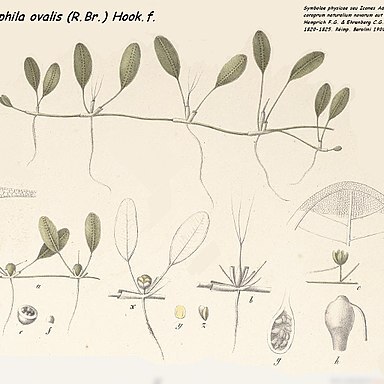Marine or estuarine, submerged sometimes intertidal, dioecious, perennial herb. Rhizomes fleshy, 1–2 mm diam.; scales suborbicular to obovate, 2–5 mm long. Leaves with petiole as long as or longer than blade; blade oblong to ovate, 10–45 mm, long, 5–15 mm wide, entire, rounded at apex, not membranous, glabrous; cross veins 12–24 pairs, forked. Spathal bracts 5–10 mm long, lanceolate, enclosing either a male or a female flower. Male flowers with pedicel to 35 mm long; tepals imbricate, hooded, 3–6 mm long; anthers 2–4 mm long; pollen grains ellipsoid. Female flowers sessile on rhizome nodes; hypanthium 3–8 mm long; tepals 1 mm long; ovary ovoid, 1–2 mm diam.; styles 3, 10–45 mm long. Fruit ovoid to globose, 3–5 mm diam. Seeds 4–30, subglobose, 0.5 mm diam.; testa reticulate.
Creeping stems elongated, internodes 1-5 cm; scales orbicular to obovate, keeled, 4-5.5 × 3-3.5 mm, membranous, transparent; lateral shoots scarcely developed. Leaves 1-paired at each node; petiole 1-4.5 cm; leaf blade transparent, oblong-elliptic or ovate, 1-4 × 0.5-2 cm, entire, with 12-16(-25) pairs of cross veins running from midvein to intramarginal veins and diverging from midvein at an angle of 45-60°. Male spathes broadly lanceolate, ca. 4 mm; perianth segments elliptic, ca. 4 mm. Female spathes broadly lanceolate, with a neck at apex, inner one enclosed within outer one; ovary slightly triangular; styles long, slender; stigmas 3, 2-3 cm. Fruit ellipsoid-globose, 3-4 mm in diam.; beak 4-5 mm. Seeds numerous, ca. 1 mm. Fl. Nov-Dec. 2n = 18.
Dioecious. Rhizomes long, branching; internodes about 2-4 cm long, light yellow, thin, brittle. Leaves in pairs, subtended by bracts; petiole 1-3 cm long; lamina variable in shape and size, linear to lanceolate or ovate ('racquet-shaped'), 10-15 mm long and 2-8 mm wide, green often with brown transverse lines, apex acute, or rounded, base attenuate or rounded. Male flowers shortly pedicellate, with 3 concave perianth segments, 4 mm long and 2 mm broad; anthers oblong, 2-4 celled. Female flowers enclosed in 2 concave, ovate bracts, consisting of an ovoid, beaked ovary 4 mm long, terminating in 3 styles 10-20 mm long, soon deciduous. Fruit globular, 4 mm in diameter with the beak persistent. Seeds c. 20, rounded, 1 mm long, tuberculate, reticulate.
Perennial herb, submerged marine, aquatic plant, dioecious, with much-branched creeping rhizome; rhizomes with long root hairs, with abbreviated shoot and a pair of leaves at nodes. Leaves in pairs, petiolate, linear, lanceolate, with a prominent, lateral, marginal nerve, connected to midrib by many oblique secondary nerves. Flowers solitary; spathe of 2 free, overlapping, membranous bracts. Male flowers shortly pedicelled, with 3 perianth segments; stamens 3; anthers sessile, pollination hydrophilous. Female flower sessile; ovary ovoid, beaked, bearing 3 reduced perianth segments near apex; styles 2-6, linear.
Monoecious or dioecious, creeping marine aquatic exposed only at very low tides. Leaves paired, linear to ovate. Flowers minute, solitary in axils of secondary branches.


